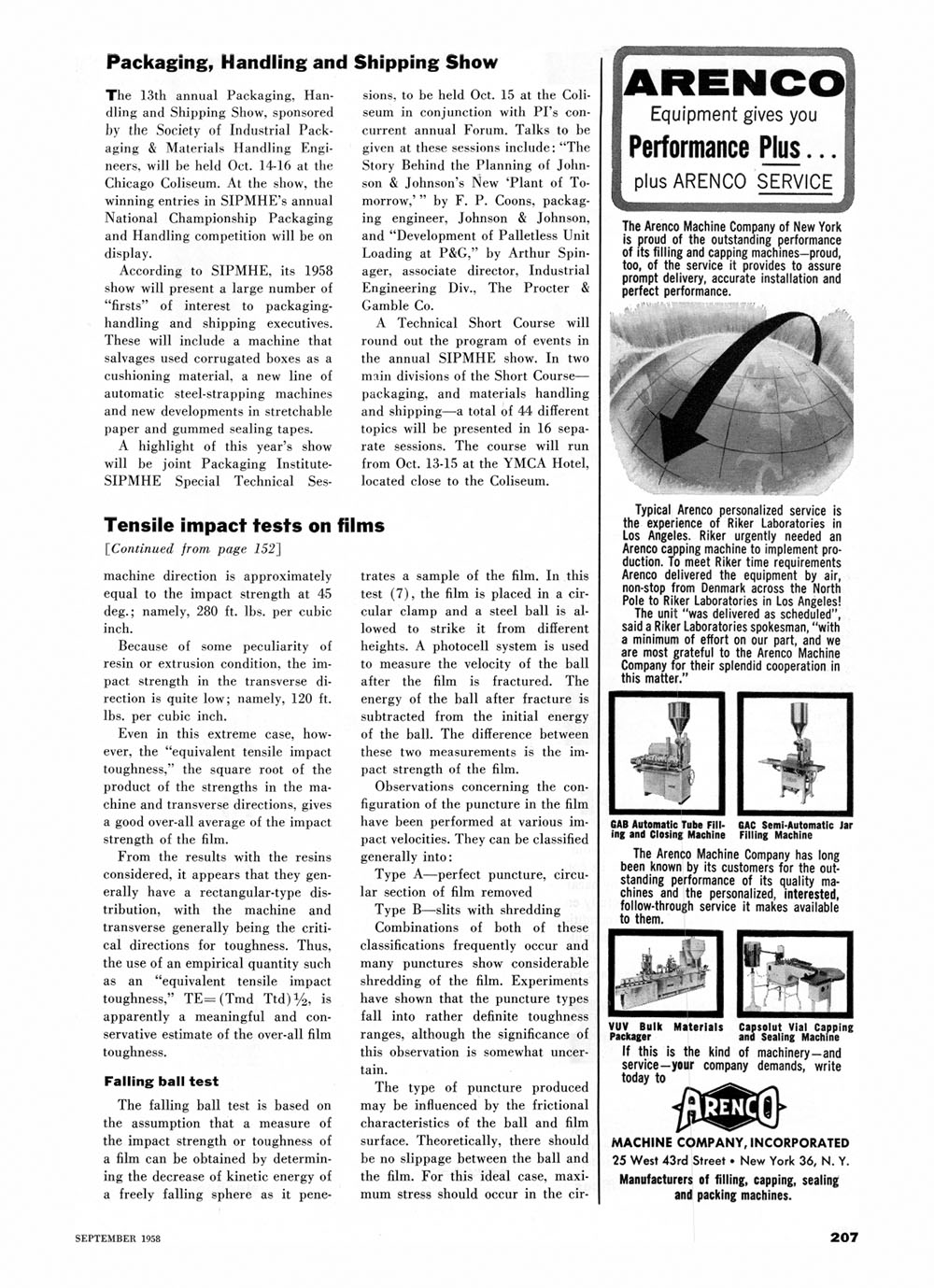


Packaging, Handling and
The 13th annual Packaging, Handling and Shipping Show, sponsored by the Society of Industrial Packaging & Materials Handling Engineers, will be held Oct. 14-16 at the Chicago Coliseum. At the show, the winning entries in SIPMHE's annual National Championship Packaging and Handling competition will be on display.
According to SIPMHE, its 1958 show will present a large number of "first- of interest to packaginghandling and shipping executives. These will include a machine that salvages used corrugated boxes as a cushioning material, a new line of automatic steel-strapping machines and new developments in stretchable paper and gummed sealing tapes.
A highlight of this year's show will be joint Packaging Institute-SIPMHE Special Technical Ses-
Tensile impact tests on
['Continued from page 152]
machine direction is approximately equal to the impact strength at 45 deg.; namely, 280 ft. lbs. per cubic inch.
Because of some peculiarity of resin or extrusion condition, the impact strength in the transverse direction is quite low; namely, 120 ft. lbs. per cubic inch.
Even in this extreme case, however, the "equivalent tensile impact toughness," the square root of the product of the strengths in the machine and transverse directions, gives a good over-all average of the impact strength of the film.
From the results with the resins considered, it appears that they generally have a rectangular-type distribution, with the machine and transverse generally being the critical directions for toughness. Thus, the use of an empirical quantity such as an "equivalent tensile impact toughness," TE= (Tmd Ttd)Β½, is apparently a meaningful and conservative estimate of the over-all film toughness.
Falling ball test
The falling ball test is based on the assumption that a measure of the impact strength or toughness of a film can be obtained by determining the decrease of kinetic energy of a freely falling sphere as it pene-
Shipping Show
sions, to be held Oct. 15 at the Coliseum in conjunction with Pi's concurrent annual Forum. Talks to be given at these sessions include: "The Story Behind the Planning of Johnson & Johnson's New "Plant of Tomorrow,' " by F. P. Coons, packaging engineer, Johnson & Johnson, and "Development of Palletless Unit Loading at P&G," by Arthur Spin-ager, associate director, Industrial Engineering Div., The Procter & Gamble Co.
A Technical Short Course will round out the program of events in the annual SIPMHE show. In two main divisions of the Short Course packaging, and materials handling and shipping a total of 44 different topics will be presented in 16 separate sessions. The course will run from Oct. 13-15 at the YMCA Hotel, located close to the Coliseum.
films
trates a sample of the film. In this test (7), the film is placed in a circular clamp and a steel ball is allowed to strike it from different heights. A photocell system is used to measure the velocity of the ball after the film is fractured. The energy of the ball after fracture is subtracted from the initial energy of the ball. The difference between these two measurements is the impact strength of the film.
Observations concerning the configuration of the puncture in the film have been performed at various impact velocities. They can be classified generally into:
Type A perfect puncture, circular section of film removed Type B slits with shredding Combinations of both of these classifications frequently occur and many punctures show considerable shredding of the film. Experiments have shown that the puncture types fall into rather definite toughness ranges, although the significance of this observation is somewhat uncertain.
The type of puncture produced may be influenced by the frictional characteristics of the ball and film surface. Theoretically, there should be no slippage between the ball and the film. For this ideal case, maximum stress should occur in the cir-
lARBNCO
Equipment gives you
Performance Plus...
plus ARENCO SERVICE
The Arenco Machine Company of New York is proud of the outstanding performance of Sts filling and capping machines-proud, too, of the service it provides to assure prompt delivery, accurate installation and perfect performance.
Typical Arenco personalized service is the experience of Riker Laboratories in Los Angeles. Riker urgently needed an Arenco capping machine to implement production. To meet Riker time requirements Arenco delivered the equipment by air, non-stop from Denmark across the North Pole to Rilker Laboratories in Los Angeles!
The unit "was delivered as scheduled", said a Riker Laboratories spokesman, "with a minimum of effort on our part, and we are most grateful to the Arenco Machine Company for their splendid cooperation in this matter,"
CAB Automatic Tube Fill- GAC Semi-Automatic iar ing and Closing Machine Filling Machine
The Arenco Machine Company has long been known by its customers for the outstanding performance of its quality machines and the personalized, interested, follow-through service it makes available to them.
VUV Sulk Materials Capsoiut Vial Capping Packager and Sealing Machine
If this is the kind of machinery-and
MACHINE COMPANY, INCORPORATED
25 West 43rd Street • New York 36, N. Y. Manufacturers of filling, capping, sealing and packing machines.